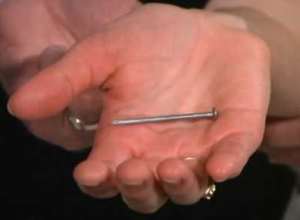

MedFriendly®


Astereognosis
Astereognosis is the inability to recognize objects by
touch alone (e.g., without seeing them) even though the
sense of touch and proprioception is intact.
Proprioception is the sense of being aware of positions
and movements of the body. Astereognosis is often
caused by damage to the parietal lobe of the brain. The
parietal lobe is the middle area of the top part of the
brain (on both sides) and is responsible for integrating
sensory information to form perceptions and spatial
sense. For people with astereognosis, the damage in
the parietal lobe is located opposite of the side of the
body where they cannot identify objects with touch. For
example, if a person with astereognosis cannot identify
objects with his/her left hand, the damage is in the right
side of the parietal lobe.
A person with asterognosis will
not be able to identify the nail
by sense of touch.
FEATURED BOOK: Sensation: The New Science of Physical Intelligence
Asterognosis can also be caused by damage to the posterior association areas of the
brain opposite of the affected limb. Posterior association areas are areas in the back
part of the brain that integrate information from various brain regions, specifically the
parietal lobes, occipital lobe (back area of the brain that deals with vision), and the
temporal lobes (side part of the brain important for memory and emotional regulation).
Astereognosis can also be caused by damage to the posterior (dorsal) column of the
spinal cord because this is an area that is important for fine touch. Astereognosis is also
known as tactile agnosia, stereoagnosis, and stereoanesthesia. Astereognosis comes
from the Greek word "a" meaning "without," the Greek word "stereos" meaning "solid," and
the Greek word "gnosis" meaning "knowledge." Put the words together and you get
"without knowledge of solids," referring to objects.
"Where Medical Information is Easy to Understand"™















